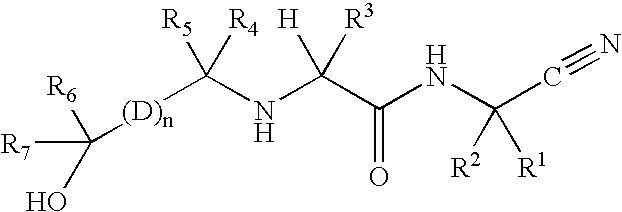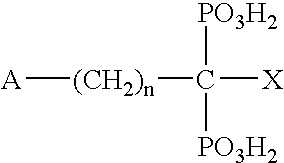Cathepsin cysteine protease inhibitors
a protease inhibitor and cathepsin technology, applied in the field of cathepsin cysteine protease inhibitors, can solve the problems of high risk of fracture, large segment of the older population already has low bone density, morbidity and mortality in the elderly population, etc., and achieve the effect of preventing cathepsin-dependent conditions
- Summary
- Abstract
- Description
- Claims
- Application Information
AI Technical Summary
Benefits of technology
Problems solved by technology
Method used
Image
Examples
example 1
Synthesis of N1-(1-cyanocyclopropyl)-N2-((1S)-1-{4′-[(1R)-2,2-difluoro-1-hydroxyethyl]biphenyl-4-yl}-2,2,2-trifluoroethyl)-4-fluoro-L-leucinamide
[0190]
Step 1: Preparation of 1-(4-bromophenyl)-2,2-difluoroethanone
[0191] To a cold (−78° C.) stirred solution of 1,4-dibromobenzene (86.4 g, 366 mmol) in tetrahydrofuran (800 mL) was added n-butyllithium (228 mL, 1.6 M in hexanes, 366 mmol). This was stirred at −78° C. for 30 min and to this slurry was added ethyl difluoroacetate (50 g, 402 mmol) over 2 min. This was stirred at −78° C. for 1 h. The reaction was quenched with 1 N hydrochloric acid (250 mL) and let warm to room temperature. The media was diluted with methyl tert-butyl ether (250 mL) and the layers were separated. The organic was washed with brine (100 mL), dried (MgSO4) and concentrated under reduced pressure. The residue was distilled under vacuum to obtain the difluoroketone as a white glassy solid.
Step 2: Preparation of (1R)-1-(4-bromophenyl)-2,2-difluoroethanol (Analo...
example 2
Synthesis of N1-(1-cyanocyclopropyl)-N2-((1S)-1-{4′-[(1S)-2,2-difluoro-1-hydroxyethyl]biphenyl-4-}-2,2,2-trifluoroethyl)-4-fluoro-L-leucinamide
[0195]
Step 1: Preparation of (1S)-1-(4-bromophenyl)-2,2-difluoroethanol
[0196] The ketone prepared in step 1 of example 1 (2.35 g, 10 mmoles) and commercial S-Alpine Borane (3.1 g, 12 mmoles) were mixed together at room temperature and stirred for four days with some gas evolution. After four days, 1H NMR of an aliquot showed the presence of starting material. More S-Alpine Borane (1 mL) was added and stirring continued for 2 additional days. 1H NMR of an aliquot showed total consumption of the ketone. The reaction was cooled to 0° C. for the addition of acetaldehyde (393 uL, 7 mmoles). The bath was removed and stirring was continued at room temperature for 30 minutes. Diethyl ether (20 mL) was added followed by ethanolamine (966 uL, 16 mmoles). The mixture was stirred at room temperature for an hour. The precipitate was removed by filtratio...
example 3
Synthesis of N1-(1-cyanocyclopropyl)-4-fluoro-N2-{(1S)-2,2,2-trifluoro-1-[4′-(2,2,2-trifluoro-1-hydroxyethyl)biphenyl-4-yl]ethyl}-L-leucinamide
[0198]
Step 1: Preparation of 1-(4-bromophenyl)-2,2,2-trifluoroethanol
[0199] To a room temperature solution of commercial 4′-bromo-2,2,2-trifluoroacetophenone (100 mg) in 1.9 mL of methanol was added sodium borohydride (15 mg). The mixture was stirred at room temperature overnight. Water was added, extracted with methyl t-butyl ether (3×20 mL) washed with water and brine. It was dried with magnesium sulfate and the solvent removed under reduced pressure to yield the title compound and it was used as such for the next step.
[0200]1H NMR of title compound (CDCl3) δ (ppm): 7.55(2H, d), 7.35(2H, d), 4.92-5.05(1H, m), 3.20(1H, s).
Step 2: Preparation of N1-(1-cyanocyclopropyl)-4-fluoro-N2-{(1S)-2,2,2-trifluoro-1-[4′-(2,2,2-trifluoro-1-hydroxyethyl)biphenyl-4-yl]ethyl}-L-leucinamide
[0201] A stream of nitrogen was passed through a solution of DMF ...
PUM
| Property | Measurement | Unit |
|---|---|---|
| active weight | aaaaa | aaaaa |
| time | aaaaa | aaaaa |
| time | aaaaa | aaaaa |
Abstract
Description
Claims
Application Information
 Login to View More
Login to View More - R&D
- Intellectual Property
- Life Sciences
- Materials
- Tech Scout
- Unparalleled Data Quality
- Higher Quality Content
- 60% Fewer Hallucinations
Browse by: Latest US Patents, China's latest patents, Technical Efficacy Thesaurus, Application Domain, Technology Topic, Popular Technical Reports.
© 2025 PatSnap. All rights reserved.Legal|Privacy policy|Modern Slavery Act Transparency Statement|Sitemap|About US| Contact US: help@patsnap.com



